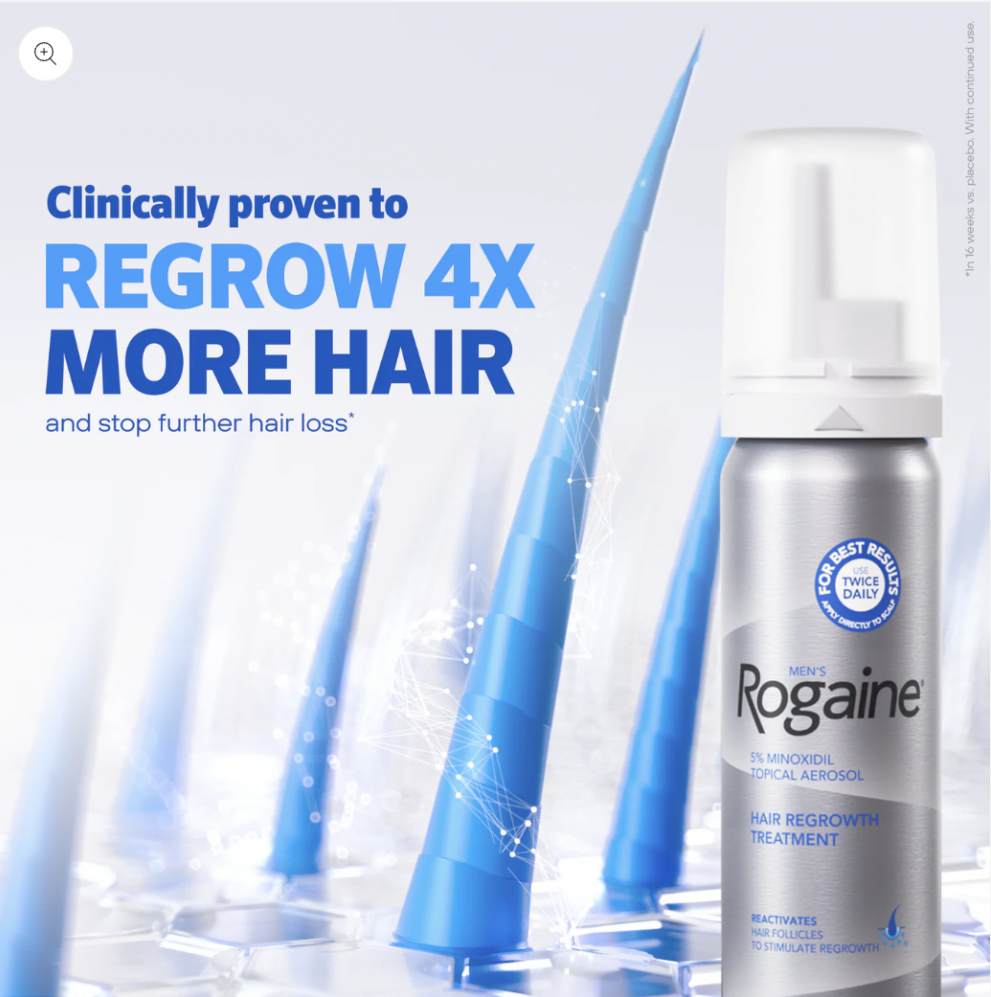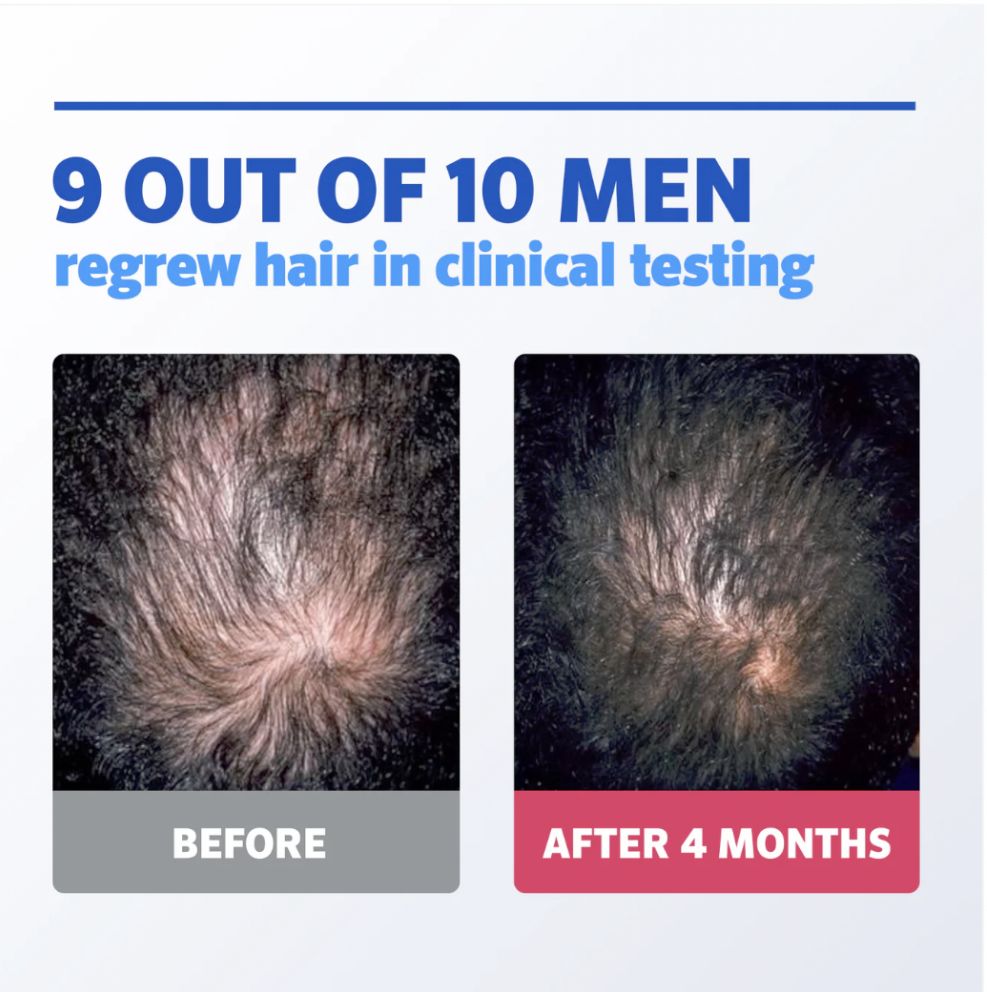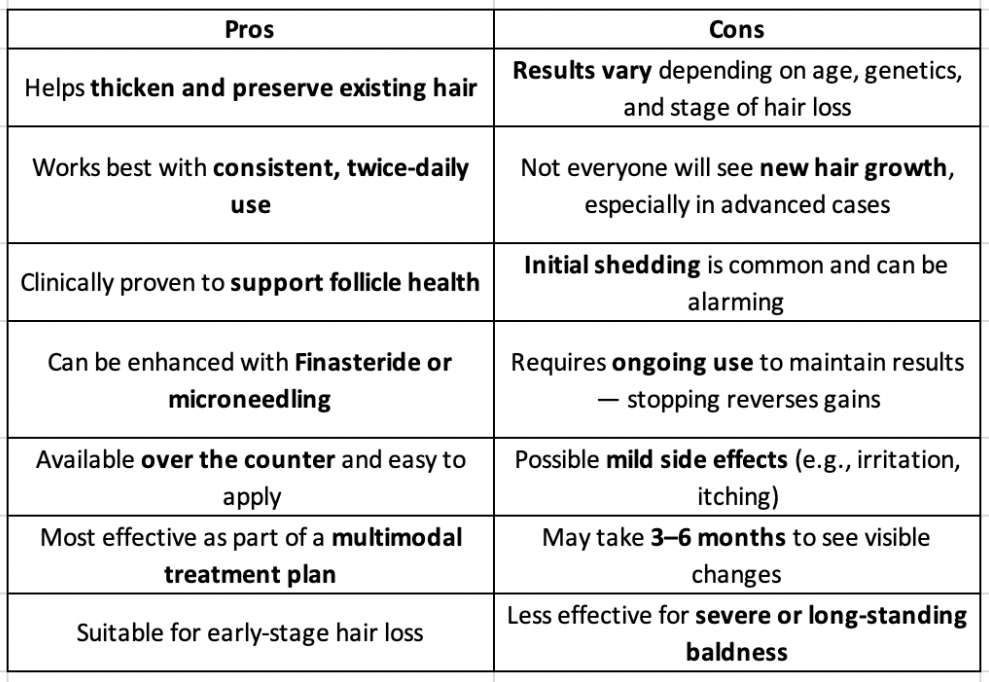I have spent some time researching products related to hair loss and wanted to share my findings on Rogaine For Men (Known as Regaine for Men in the UK).
Rogaine For Men is the brand name for a 5% topical Minoxidil solution that has been scientifically supported as an option for treating hair loss. This formulation is available as both a foam and a solution, and it is applied directly to the scalp. There is also a shampoo & conditioner available.

In this review, I provide a detailed look at Rogaine For Men, explaining its mechanisms, usability, benefits, and limitations based on both clinical research and user experiences. My goal is to offer clear insights to help you make an informed decision about whether this product might be the right choice for your hair care routine.
Overview
Product: Rogaine for Men
Website: www.rogaine.com
Rating: 6 out of 10
Cost: From $45 for a 3 month supply
Key Benefits of Rogaine for Men
Rogaine for Men offers several key benefits for those experiencing hair thinning or early-stage hair loss. It is clinically proven to slow down hair shedding, particularly in cases of androgenetic alopecia (male pattern baldness), and helps stimulate regrowth by encouraging dormant follicles to re-enter the growth phase.
With regular use, many users notice an improvement in hair density, thickness, and overall strand strength. Results typically become visible within three to six months, especially when the treatment is started early.
One of the major advantages of Rogaine is that it’s available over the counter and is easy to apply as a topical foam or liquid solution. Additionally, Rogaine can be safely combined with other hair restoration methods like Finasteride, microneedling, red light therapy, or rosemary oil to enhance outcomes. Because it’s a topical treatment, Rogaine tends to have a lower risk of systemic side effects compared to oral medications.

How Rogaine For Men Works
Rogaine for Men contains Minoxidil, a topical vasodilator that was originally developed to treat high blood pressure. When applied to the scalp, Minoxidil works by widening the blood vessels, which improves blood flow to hair follicles. This increased circulation helps deliver more oxygen and nutrients to the follicles, which can revive shrunken or dormant follicles and extend the active growth phase of the hair cycle (known as the anagen phase).
As a result, hair strands may grow in thicker, stronger, and more densely, and existing hair is better preserved. While it doesn’t cure baldness or regrow hair in completely bald areas, it can significantly slow hair loss and support regrowth in thinning areas—especially when used consistently over time.
It’s most effective in early to moderate stages of male pattern hair loss and requires ongoing use to maintain results. Once you stop using it, any new hair gained is likely to be lost over time.
It is important to note that the process demands patience, as results might not be visible for 3 to 6 months of consistent use. For anyone new to topical treatments, understanding that this is a long-term commitment can help set realistic expectations from the start.
📊 Key Clinical Studies & Findings
1. The 5% Minoxidil Advantage
A landmark study published in the Journal of the American Academy of Dermatology (Olsen et al., 2002) compared 5% Minoxidil to the 2% concentration and found that:
- Men using 5% Minoxidil had 45% more hair regrowth than those using 2%.
- Hair counts were significantly higher at week 48, and users reported higher satisfaction.
- Improvements were seen as early as 8 weeks with continued gains over time.
2. Real-World Use in 417 Men
A 2023 clinical study evaluated 417 men using either branded Rogaine or a generic 5% Minoxidil foam for 24 weeks. The results showed:
- Both groups experienced significant increases in hair density and thickness.
- There was no statistically significant difference between the branded and generic products.
- This supports that it’s the active ingredient, not the brand, that delivers the benefits.
The active ingredient in Rogaine is identical to other generic 5% Minoxidil formulations, yet the product’s popularity stems from brand recognition, trusted packaging, and extensive clinical research that supports its effectiveness.
There are also differences in the marketing and packaging approaches across various products. For instance, while the foam formulation is quite similar between products designed for both men and women, the men’s version of Rogaine is specifically marketed with a 5% concentration in both foam and solution formats. Meanwhile, formulations aimed at women sometimes use different concentrations.
Side Effects and Safety Considerations
- Potential side effects of Rogaine for Men are generally mild and manageable.
- Common issues reported by users include:
- Scalp irritation
- Dryness
- Itchiness
- Less common side effects may include:
- Dizziness
- Headaches
- Contact dermatitis
- These side effects are primarily associated with topical application, not oral Minoxidil, which carries a different risk profile.
- Women should use extra caution:
- Accidental contact with facial areas may cause localized hair growth or mild swelling.
- When used correctly and as directed, most users find the side effects to be minor.
- It’s recommended to consult with a healthcare provider before starting treatment to ensure safe and effective use.

Application Tips and Techniques
A major factor in achieving the best results with Rogaine is following proper application techniques. I have gathered several practical tips that can help you maximize the benefits of this treatment:
- Consistent Use: It is recommended to apply the product twice a day on a dry scalp. Consistency is very important. Even occasional missed doses might impact the overall effectiveness of the treatment.
- Application Areas: Focusing application on thinner hair regions is key. Most users choose the crown or temple areas, where hair loss is more noticeable. This targeted approach can result in better real-world benefits and a more visible improvement in hair quality.
- Proper Dosage: Following the guidelines suggests using 1 ml per application. While some individuals have experimented with a single daily application, evidence indicates that sticking to the recommended twice-daily routine is the best way to support regrowth and maintain existing hair.
- Supplementary Treatments: Many users combine Rogaine with other treatments such as Finasteride, which is a DHT blocker, to further support hair growth. Additionally, methods like microneedling or red light therapy, along with natural supplements like rosemary oil, have been reported to boost outcomes by giving a boost to absorption and stimulating follicle activity. These supplementary strategies allow for a well-rounded approach to hair treatment.
Thorough attention to detail in how you apply the treatment can make a significant difference in your results.

User Experiences and Detailed Reviews
In my research, I came across a wide range of user reviews that provide a realistic perspective on the effectiveness of Rogaine For Men. Some users have reported remarkable improvements and noted visible changes in their hair quality, while others have experienced only modest benefits. The mixed bag of experiences highlights that while the product can work well for many, results may vary depending on individual factors like genetics, the extent of hair loss, and adherence to the treatment routine.
There have been some concerns raised by users:
- Not Effective for Everyone: Some users have reported no observable regrowth even after 6 or more months of persistent use. This serves as a reminder that individual responses to treatment can be very different, and genetics as well as the severity of hair loss are really important factors that can influence the outcome.
- Initial Shedding Phase: It is common for users to experience increased hair shedding during the early stages of treatment. In one case, a user felt quite discouraged during this phase, only to later find that the shedding was temporary and part of the natural cycle of hair regrowth.
- Mistrust of Marketing: Some users expressed skepticism towards the promotional materials associated with Rogaine. They felt that the marketing sometimes raises expectations that are not entirely in line with their actual experiences. This feedback is important, as it underscores the need for realistic expectations when trying any new treatment.

Frequently Asked Questions
Question: What kind of results can I expect and how long will it take?
Answer: You can expect to see visible improvements in hair density and quality after about 3 to 6 months of consistent use. Keep in mind that individual results can vary widely, and stopping the treatment may result in a reversal of the gains made.
Question: Are the foam and solution formulations equally effective?
Answer: Yes, both formulations contain 5% Minoxidil for men and are equally effective. The main differences lie in the method of application and personal preference rather than in their overall efficacy.
Question: What side effects might I experience when using Rogaine?
Answer: Common side effects include minor scalp irritation, dryness, or itchiness. Some users may also experience dizziness or headaches, especially if the product is not applied as directed. Following the usage instructions carefully helps to minimize these unwanted effects.
Question: Can I use Rogaine along with other hair loss treatments?
Answer: Many users choose to pair Rogaine with treatments such as Finasteride or procedures like microneedling. Combining these approaches has been noted to improve overall results by giving a boost to absorption and stimulating hair follicles more effectively. It is always a good idea to check in with a healthcare professional before starting a combined treatment regimen.

Final Thoughts on Rogaine For Men
Rogaine for Men is a clinically supported option for managing hair thinning and loss. While results vary, many users report improved hair quality and retention with consistent use. It’s important to have realistic expectations—initial shedding is common and part of the adjustment process. Combining Rogaine with treatments like Finasteride or microneedling can enhance results. Hair loss treatment is not a one-step fix but a long-term commitment involving proper application, supportive therapies, and patience. Consulting a healthcare professional or trichologist is recommended, especially if you have existing health concerns. Ultimately, Rogaine for Men stands out for its research-backed formula and positive user feedback. If you’re looking for a non-invasive approach to improving hair health, it could be a valuable part of your routine. The key is consistency, realistic goals, and a personalized plan tailored to your hair needs.

Thanks for the thorough and balanced review, Rebecca! I appreciate how you covered both the strengths and limitations of Rogaine for Men. It’s great to see that clinical research backs its effectiveness, especially for early-stage hair loss. Your tips on consistent application and combining treatments like Finasteride and microneedling are really helpful for anyone considering a full regimen. I also liked that you pointed out the importance of managing expectations, as results can take months and require ongoing commitment. It’s reassuring to know that side effects are generally mild, though it’s smart to consult a healthcare provider first. I hadn’t realized that the foam and solution options could be tailored depending on personal preference, which makes it even more approachable. This review definitely makes it easier to make an informed choice about starting a hair loss treatment journey!
Thank you for your comments. I’m so glad that you found the review useful and that it will help you in making a more informed choice about your treatment journey.